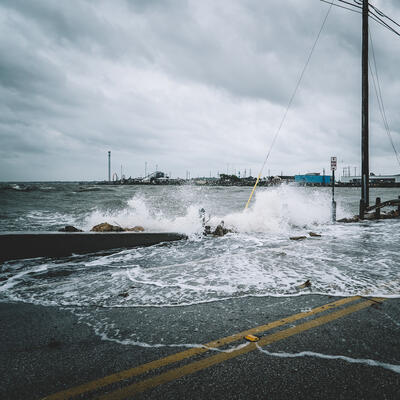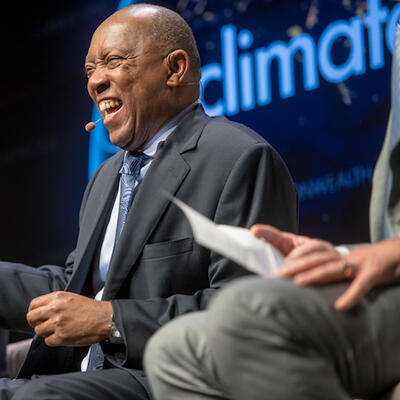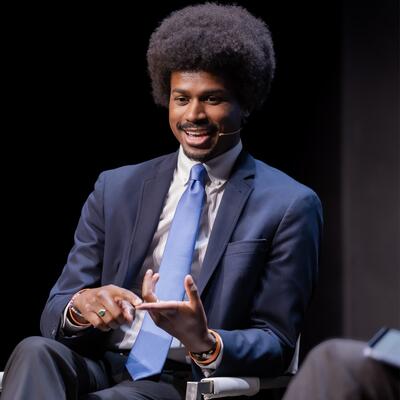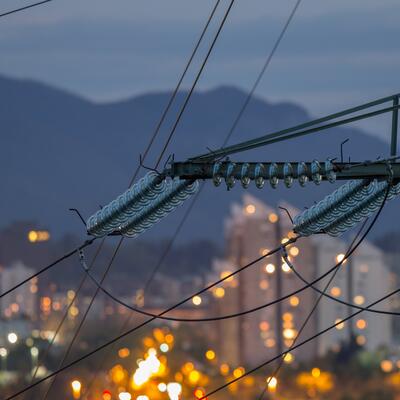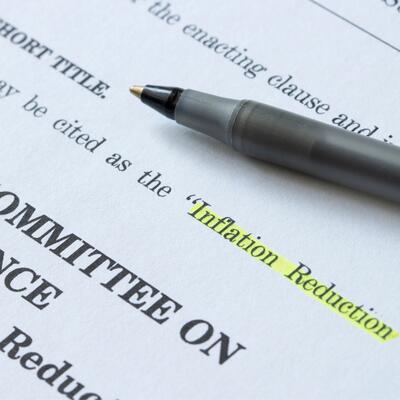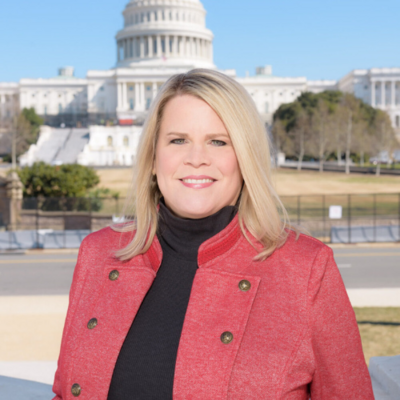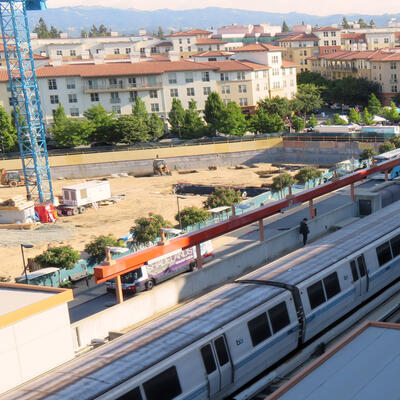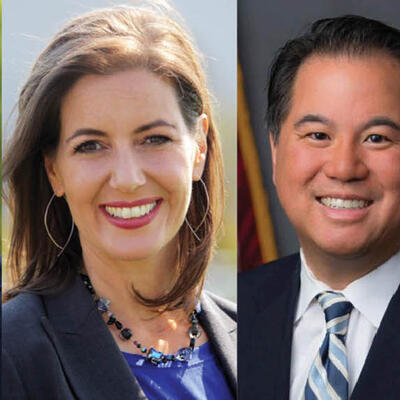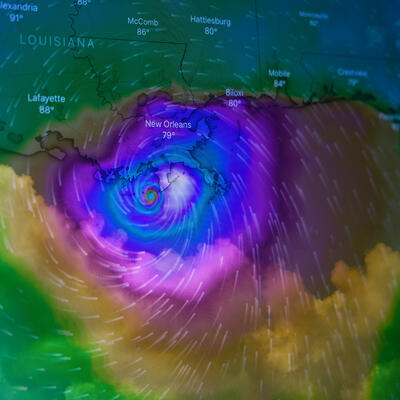
Preparing for Disasters We Don’t Want to Think About
Guests
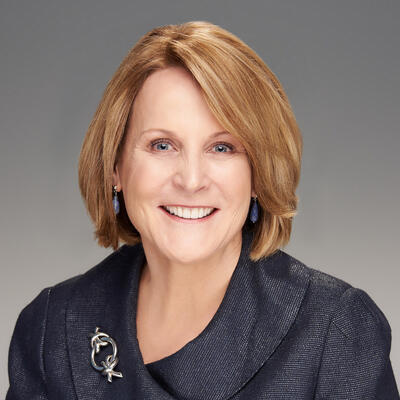
Alice Hill
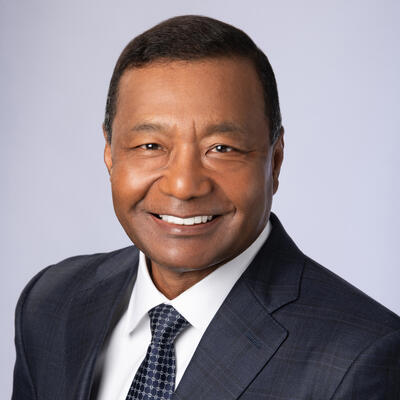
Thomas P. Bostick
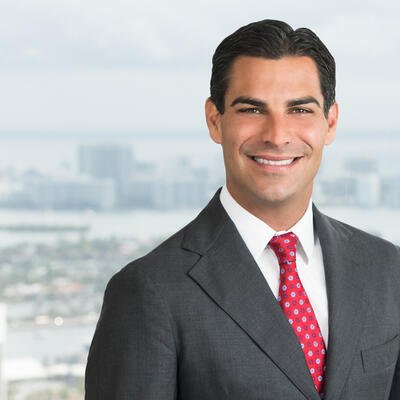
Francis Suarez
Summary
The COVID-19 pandemic revealed structural weaknesses and inequities that existed long before 2020. Like the COVID-19 pandemic, climate disruption is a threat multiplier.
In her new book, The Fight for Climate After COVID-19, Alice Hill says we need to adapt our thinking and our policies to combat the ever-increasing threat of climate change, especially as we see more compound disasters like a wildfire followed by a mudslide.
“With the pandemic, we saw all 50 states and six territories hit at once. FEMA never contemplated having to respond in that way before,” Hill says. “We need greater surge capacity, that is, a faster response that can cover more territory all at once to help communities withstand the impacts and then recover from them.”
Hill worked on climate issues at the Department of Homeland Security and the National Security Council in the Obama administration. She’s now senior fellow for climate change policy at the Council on Foreign Relations. She advocates for a nationally coordinated government approach to adaptation to climate change, though she’s aware of a “climate literacy gap” among leaders in government and the private sector.
“We need to come together to understand the risks, understand the vulnerabilities and then start making decisions with the support and the aid of the federal government to have better outcomes,” Hill says.
Tom Bostick is former commanding general of the U.S. Army Corps of Engineers. He led the Hurricane Sandy response and recovery efforts and says we should take disasters like that as opportunities to better prepare for future ones.
“Risk is all about fighting against some sort of impact,” says Bostick. “Resilience is accepting the fact that you're going to have to give way; you're going to have to fail somewhere in the system, but bounce back and bounce back even stronger.”
But building resilience requires leadership, planning, priority setting and funding – resources that can be limited, Bostick says. “On any given day, the Corps has about 3,000 projects. We receive a certain amount of appropriations every year and that money is spread like peanut butter over these projects.”
He says the federal government did invest in recovery after Hurricane Katrina, spending $135 billion on the Hurricane and Storm Damage Risk Reduction System.
“And in 2012, seven years to the day after Hurricane Katrina, Hurricane Isaac hit...and the storm system did its job down there,” Bostick says “So, our country, when put to task, can build a system that can reduce risks. We can't protect people from climate change, but we can reduce the risk.”
In 2019, citing the Paris Climate Agreement, the city of Miami declared a climate emergency and urged the State of Florida and the United States to do the same. Mayor Francis Suarez says that emergency continues to be taken seriously today. The city has also joined C40, a global network of cities committed to addressing climate change, and pledged carbon neutrality by 2050.
Despite increasingly severe storms and sunny day flooding, the mayor of Miami says continued waterfront development is a bet on the city’s focus on climate resilience.
“There are some that, for whatever reason, feel that Miami will not exist in 10 years or 20 years, or 50 years or in 10 years, and that's certainly not an acceptable outcome for me,” Suarez says. “We're dedicating resources, we’re not putting our head in the sand, and it's imperative that we do whatever it takes,” he says.
Suarez says he’s also committed to exploring how to reverse some of the effects of climate change, “so that the world that we give our children is a better world than the one that we've inherited.”
Related Links:
The Fight for Climate After COVID-19
City of Miami Climate Change Programs
Full Transcript
Greg Dalton: This is Climate One. I’m Greg Dalton. How can we prepare for a future wholly unlike the past we’ve known?
Alice Hill: We need to come together to understand the risks, understand the vulnerabilities and then start making decisions with the support and the aid of the federal government to have better outcomes.
Greg Dalton: We have proven examples of resilient solutions — but they take time, money and foresight.
Tom Bostick: Our country, when put to task, can build a system that can reduce risks. We can't protect people from climate change, but we can reduce the risk.
Greg Dalton: Despite increasingly severe storms and sunny day flooding, the mayor of Miami says continued waterfront development isn’t crazy:
Francis Suarez: I think there are some that, for whatever reason, feel that Miami will not exist in 10 years or 20 years, or 50 years or in 10 years, and that's certainly not an acceptable outcome for me.
Greg Dalton: Preparing for the next disaster. Up next on Climate One.
Greg Dalton: How do we prepare for the disasters we don't want to think about? I’m Greg Dalton.
Greg Dalton: Before we get into our conversation on building climate resilience, we’re continuing our weekly spotlight on the upcoming international climate summit in Glasgow. The day after the 2020 presidential election, the U.S. exited the Paris Climate Agreement — a non-binding international framework to reduce greenhouse gas emissions and keep a lid on global warming. The decision to quit the global climate accord dented US credentials as a reliable partner in the fight against climate disruption. Can the Biden administration undo the damage and re-establish the nation’s reputation at this year’s COP26? Climate One correspondent Aman Azhar reports:
Aman Azhar: Former President Trump’s decision to unilaterally, and abruptly, quit the Paris Agreement has created doubts about whether the US can be a reliable partner in the fight against climate crises. As the world leaders prepare for COP26 in Glasgow, the need for fully engaged global climate leadership couldn’t be more important. So, how can Washington signal it really is back as a trusted partner on the climate agenda?
Duncan McLaren: I think there's three things that the US really needs to do. The first is, domestically, it needs to take measures that would bind successor administrations. The analogy would be the UK attempt, which is to set up a climate act that binds successive governments, and provides an independent oversight of that.
Aman Azhar: That’s Duncan McLaren, Professor in Practice at Lancaster University’s Environment Center. He says it's a bit like handing over control of interest rates to a central bank rather than keeping them in the purview of the president or the government. He suggests two other ways the U.S. can prove it’s a climate partner:
Duncan McLaren: The second is to demonstrate a commitment to climate justice. And that means investing in the most vulnerable communities both domestically and internationally. And the third thing, the US government needs to do is very explicitly reject the false solutions that are out there. And two I'd mentioned in particular; the idea that we can do this through carbon trading, and similarly, the idea that we can wait for technologies of solar geoengineering.
Aman Azhar: But David Orr, the distinguished professor of environmental studies at Oberlin College, argues the influence of the fossil fuel industry on American politics contributes to the US backpedaling on climate issues.
David Orr: It’s awfully hard for the United States to maintain a commitment to any kind of climate mitigation, with the power of fossil fuel money in the US Senate and US Congress and in local elections. The real step in transformation in US politics.
Aman Azhar: Orr says the US needs to take steps at home and abroad to demonstrate its seriousness to the world community.
David Orr: We need to resolve our own doubts about this and the climate denial community which has flourished in the United States for a long time needs to be put to rest. Second thing on the policy level, historically US is the largest emitter. I think that imposes on us certain obligations to: a) reduce our own carbon emissions, and b) help the rest of the world will do that.
Aman Azhar: But US politics is a complex web of competing interests. Powerful members of the ruling Democratic party, such as Senator Joe Manchin of West Virginia, don’t support Biden administration’s historic climate spending.
Duncan McLaren: Manchin can't stop the US, for instance, going to the COP and saying, Yeah, in the past we may have looked like we're in bed with Saudi Arabia and keeping fossil fuel tabs open. Well, we want to disown that position, we're not going to do that in the future. That would help in terms of making the COP look more open to the solutions we need, which are to turn off the taps of the fossil fuel industry.
Aman Azhar: Both McLaren and Orr agree that given the uncertain US politics, America’s allies would be at best cautiously optimistic about its return to the climate table. But they warn of what a continued trust deficit could mean for global climate negotiations.
Duncan McLaren: What would worry me in the sense that we're in an era that without coordinated work through the COP system, we will see further destabilization and fragmentation and the global great powers, each developing their own set of strategies for climate securitization. We would see I think measures like geo-engineering coming on the table, we'd see countries developing climate adapted enclaves for the rich, constraining immigration further than they do now, repressing climate activism. It's not a pretty picture.
David Orr: Climate change requires that the world come together. So, this is a time for leadership. If we don't provide it, Other people will and I think in the geopolitics of the world. That is an open door to China taking the place of the United States. And that's, I think not good for the world.
Aman Azhar: A firm US commitment to this global partnership at COP26 will be crucial for a coordinated response in the face of the increasingly urgent climate emergency. For Climate One in Washington DC, this is Aman Azhar.
Greg Dalton: The climate summit in Glasgow follows extreme weather events that will become more common: heat domes, massive wildfires, superpower storms and extreme rainfall. Like the COVID-19 pandemic, climate change is a threat multiplier. Tom Bostick is former Commanding General of the US Army Corps of Engineers. He led the Hurricane Sandy response and recovery efforts and says we should take disasters like that as opportunities to better prepare for the next ones.
In her new book, The Fight for Climate After COVID-19, Alice Hill says we need to adapt our thinking and our policies to combat the ever-increasing threat of climate change. Hill worked on climate issues at the Department of Homeland Security and the National Security Council in the Obama administration. She’s now Senior Fellow for Climate Change Policy at the Council on Foreign Relations.
Greg Dalton: Hill says shortly after she arrived at the Obama White House in 2013, a senior official on the National Security Council stopped by her office and gave her a warning.
Alice Hill: Someone stood in my doorway and said, you're getting a reputation. I said, reputation for what? He said, for worrying too much about climate change. And of course, I took that in and I realized that that probably signaled the person and whoever else was saying this just simply didn't understand the nature of climate risk, how it's accelerating, growing, and will affect everything eventually.
Greg Dalton: That's quite startling in the second Obama term when climate was a big issue. So, what did that say to you that even a high-ranking government official in the White House didn't understand in 2014 the extent of climate risk?
Alice Hill: It said to me that we have a climate literacy gap among leaders and that's true both in government as well as in the private sector. And that gap in knowledge, it's understandable it hasn't been taught in schools as required curricula so it's not surprising that leaders don't know much about climate change. And you could underestimate it if you don't know a lot about it.
Greg Dalton: There’s another root of that comment is how people perceive risk which you write is partly a function of how quickly an example of risk comes to mind, how recent and relatable it is. So, compare the risks of climate and COVID-19 and how you think humans perceive those threats.
Alice Hill: Well, both of them are threats that are catastrophic. But with pandemics, history has been teaching us that a pandemic could occur. We had the flu in 1918. We've had the plague in the 14th century. So that's part of the narrative that people learn about. With climate change these are risks that had never occurred in human history completely unfamiliar and therefore turns out our brains and the social scientist tell us this aren’t particularly good at judging how bad that risk could get.
Greg Dalton: Right. There’s kind of a human tendency if it hasn't happened before, it can't happen. Tom, but we know that there are lessons from the past that you often refer to Hurricane Betsy which hit New Orleans in 1965, breaching levees and inundating several neighborhoods. What are the lessons of Hurricane Betsy and how they relate to Hurricane Katrina and Hurricane Ida that just slammed Louisiana and the Northeast?
Thomas Bostick: One thing about disasters is after a major disaster it presents an opportunity for the country at the federal level and the local level to do something. So, after Hurricane Betsy in 1965 the Corps of Engineers was directed to build a hurricane protection system. And by the time Hurricane Katrina hit in 2005, 40 years later we were about 50% complete. And part of the challenge with that is setting priorities or the lack of ability to set priorities. And on any given day, the Corps has about 3000 projects. We receive a certain amount of appropriations every year and that money is spread like peanut butter over these projects. But after Hurricane Katrina and the disaster that was caused then and the federal government invested about $135 billion in the recovery effort, 14 1/2 billion went to the Corps of Engineers. And the Corps of Engineers calls the project that's there the Hurricane and Storm Damage Risk Reduction System, HSDRRS. It’s not a very good name but one word that's not in there is protection because we really cannot protect life and property against certain storms, we reduce the risk. And in 2012, seven years to the day after Hurricane Katrina, Hurricane Isaac hit. And most people don't know about Isaac, but it had storm surges of 12 to 14 feet which is pretty significant and the storm system did its job down there. And similarly, with Hurricane Ida most folks that have seen the system up close and personal during this last storm realized that the system worked. So, our country when put to task can build a system that can reduce risks. We can't protect people from climate change, but we can reduce the risk.
Greg Dalton: Right. And so, it worked for Isaac and does seem to have worked for Ida though the levees are sinking and will need more work to continue protecting the city. So, are you saying that the dynamics change with the Army Corps that they’re no longer spreading peanut butter that they're kind of concentrating their efforts more focused and therefore getting better results?
Thomas Bostick: I think we've received a significant amount of money from the congress and that money, combined with the local level is helping us to put an adequate amount of funds in that area. But with sediment issues, with the sea level rise and the storm surges we’re gonna continue to see a need for that part of the country to consider what options they have 10, 20, 50 years into the future.
Greg Dalton: Right. We’re buying time with big price tags. Alice, the recent IPCC Report warned of compound events. One disaster on top of another. Wildfires and power outages, hurricanes and a pandemic. The convergence of big disasters is stretching FEMA to the breaking point. So how can communities build resilience to come back after a double or triple whammy like we’re seeing right now?
Alice Hill: Well, there are a number of ways. First of all, they need to plan and they need to account for the future risk of climate change. But also, we need to focus on our emergency management. It's a different game now. With the pandemic we saw all 50 states and six territories hit at once FEMA never contemplated having to respond in that way before, but now we know a drought may cause or contribute to a wildfire and then following the wildfire there might be a mudslide. So, all of that causes greater damage to communities than we are familiar with. And we need greater surge capacity that is a faster response that can cover more territory all at once to help communities withstand the impacts and then recover from them. So, it could be having more capability for fighting wildfires, more planes available. It could be having a resilience corps as Paris has created of citizens who could go out and help post-disaster make sure that recovery goes as smoothly as possible. It also means strengthening our supply chains as we have learned during the pandemic. We can't assume that these reedy thin supply chains that or like a net across the globe are going to hold during multiple catastrophes.
Greg Dalton: General Bostick, you've talked about how the Army Corps has learned some lessons from recent Katrina, etc. After Katrina, the head of the Army Corps Chief Carl Strock retired because the system designed to protect New Orleans actually worsened the damage there. As Alice Hill talks about all these multiple and compounding disasters that are happening on broader scale than people imagined before, what does that mean for how the Army Corps thinks about its work and you might describe a little bit of explaining for people who aren’t exactly familiar with the Army Corps does other than maybe dredging ports and other things.
Thomas Bostick: The Army Corps of Engineers has been around since before the country was even formed. The Corps of Engineers has been imminently involved in the growth of our nation. But the Corps has two parts. It's got a civil part and it's got the military part. And the military part of the Corps of Engineers works on military installations they deployed to Iraq and Afghanistan. One thing I wanted to talk about in addition when Alice discussed on resilience. I think one of the best lessons of resilience we learned again back after the flood of 1927. And the flood of 1927 was really a bad flood; it caused huge issues for the country, particularly in the New Orleans and along the Mississippi River. And the Corps of Engineers was directed once again by congress to build the Mississippi River and tributary system. And it’s a system of locks and levees throughout the Mississippi that will help control the river and control flooding. But risk is all about fighting against some sort of impact. Resilience is accepting the fact that you're going to have to give way, you're going to have to fail somewhere in the system but bounce back and bounce back even stronger. So, what happened in 2011 a huge amount of water came down the Mississippi and if anybody remembers that flood in 2011, they remembered a two-star general blowing up the levee just south of St. Louis. We don't call it blowing up the levee in the Corps of Engineers, we say we operated the floodway. And what we did is we had dynamite in this one area where we knew that would be so much pressure along the Mississippi that if we blew up the levee or operated the floodway we would open up a 5 mile wide 65 mile long area where the water could - it was a relief valve - the water could just pour into this area and then it would save lives and save property down through the Mississippi.
Greg Dalton: And some people hearing that story, Tom Bostick, well, that’s returning nature to the way it was and the way it should be. That there's been kind of this trying to channel rivers and this kind of arrogance of trying to control nature through steel and concrete. Which gets to the point of thinking about the Army Corps is often thought about structures on heavy on steel and concrete. What other ways can we use nature to build resilience that might displace concrete and other ways of we’ve been approaching nature in the last few decades?
Thomas Bostick: You know, the Corps never raises its hand and says, I wanna do this mission I've got a great idea. Let me go build this dam or build this levee. What we do is what the American people want. And an interesting story I think about is when I was a young major, I was the aide to the Chief of Engineers. And we flew down to a project that it was called Kissimmee, the Kissimmee River Project, where the local residents in the state wanted to turn this river into basically a culvert that would move the water faster and they'd have control of it for irrigation and other purposes. We thought and explained that that would kill the environment that would depend on that river. Years later I'm the Chief of Engineers and I go back down to the Kissimmee River and they’re beating up on the Corps of Engineers for building this culvert and they want us to change it back. So, that’s what we did. And what happened in those years since I was a major to becoming the chief engineer, society, the people of America became more environmentally conscious. They started to really appreciate what the natural environment and the benefits of the natural environment gave to them. So, the Corps spends a lot of time thinking about living shorelines and ecosystem restoration and what are the kind of things we can do in concert with the other priorities that we have in the Corps which are flood risk management and navigation.
Greg Dalton: You’re listening to a Climate One conversation about preparing for future climate disasters. Our podcasts typically contain extra content beyond what’s heard on the radio. If you missed a previous episode, or want to hear more of Climate One’s empowering conversations, subscribe to our podcast wherever you get your pods. Coming up, the crucial importance of planning and preparing for future crises:
Tom Bostick: Part of the challenge I think is that we’re often very short-term focused. And climate change happens over time. The challenge is, by the time it hits you there’s almost not much left that you can do.
Greg Dalton: That’s up next, when Climate One continues.
Greg Dalton: This is Climate One. I’m Greg Dalton, and we’re talking with Tom Bostick, former Commanding General of the US Army Corps of Engineers, and Alice Hill, who worked on climate change issues at the Department of Homeland Security and the National Security Council in the Obama administration. Hill advocates for a nationally coordinated government approach to adaptation to climate change. But as we’ve seen with the COVID pandemic, fractured politics can make a mess of these things. I asked her how we can overcome that.
Alice Hill: We are fractured and that makes it difficult when some are not convinced about the severity of climate change. But despite that division in our politics the one thing that we can do is start planning. And what needs to happen now is the federal agencies must began to focus on what this climate risk mean for their particular mission set be it at the Department of Homeland Security, which is responsible for our borders and with Coast Guard our waterways or the Army Corps of Engineers and their responsibilities that you've heard about or HUD and its responsibilities for helping provide housing. All of these agencies need to come together and they need a framework that will allow them to have not only a whole of government approach to this growing risk but also whole of society. We need to come together to understand the risks, understand the vulnerabilities, and then start making decisions with the support and the aid of the federal government to have better outcomes, more resilience as Tom has said.
Greg Dalton: Gen. Bostick, you said that the Army Corps spreads money like peanut butter thinly across the whole country. There used to be federal earmarks which were, you know, some called it pork funding that individual members of congress can bring home to their constituents that was eliminated some years ago gradually making a comeback. Do you think that would help set priorities for national priorities which you said the Army Corps doesn't do?
Thomas Bostick: The Corps has a hand in setting priorities they must work with the federal government which does the authorization the appropriations and then also with the states who cost share a lot of these projects. But I think the priorities is a very important part of this equation, but going back to what Alice was speaking about. We have to come together as a nation and it's got to be the public sector and the private sector, all working together in a systematic way to address the challenges that we face. I don't like disasters but I’ve been around for a number of them and one of the things I do like is how the nation comes together after them. I saw what we did after Katrina, and then Superstorm Sandy. And climate change is an international systematic challenge that we have to take on as an entire system.
Greg Dalton: Tom, you say that no one wants to talk about retreat or what's often called managed retreat. What is that and why don't people want to talk about it?
Thomas Bostick: Part of the challenge I think is that we’re often very short-term focused. And climate change happens over time. The challenge is, by the time it hits you there’s almost not much left that you can do. One of the great things I think that came out of Superstorm Sandy is that congress said, Corps of Engineers we want you to do a study of the northeast coast 31,500 miles of coastline. We want you to look out 50 to 100 years and do an analysis and come back and let America know what we should be doing. So, we brought in some of the best minds in organizations together provided this report the budget was for about $20 million provided it after year on time and within budget. And part of it came back to, we needed resilient communities. And we looked at things like barrier islands in 20 to 25 years from now some of these barrier islands are going to be underwater. So, the question is, if you have a home there you don't see that, you're not feeling 20 to 25 years, but your children will. And the kind of decisions that have to be made include retreat in my mind but it's a hard thing to do and I can appreciate how hard it is because it's a livelihood, it's the history, it's everything to people if you tell them they have to leave a certain coastline community or barrier island.
Greg Dalton: Alice, how do you think about that there are some very difficult decisions to be made about which communities are protected. There is a bias toward protecting high property values which means lower income neighborhoods with less property value are less likely to get public resources. How do you think about managed retreat as climate hits harder and harder along waterlines?
Alice Hill: Look, this is gonna be a really tough challenge for everyone and we have to put ourselves in the shoes of those who might have to move away from risk. It could be in a wildfire zone or it could be a coastal zone, a riverine, along rivers edge. And that’s a very emotional decision to ask people to leave their homes, their communities, the people they love and to move somewhere else. It's a conversation, however, that the federal government has an important role to play because that retreat or movement could happen very suddenly, as it happened with a wildfire in California. After Paradise burned, 20,000 people moved into the town of Chico overnight, a town with about 100,000 people in population. So, imagine the kindergartens are all of a sudden filled, affordable housing, which was already unaffordable becomes even more unaffordable. The streets are clogged. So, we need to plan which communities will be the receiving communities. More people are moving into areas that are at flood risk and fire risk than other areas. So, can the federal government give incentives to help people understand that investment, your primary investment, your home may not be so wise as Thomas said in 20 years.
Greg Dalton: So, you’ve been talking there all about policy and government. What's the role of markets? I'm amazed that banks are still writing mortgages on a waterfront condominium in certain places. I wonder, you know, what the banks are thinking if they’re writing 15, 30-year mortgages. Somebody's going to get left financially holding the bag. So, what are the financial incentives? This isn't just a government responsibility to give people signals about where it's risky to live and where they might move.
Alice Hill: Well, I think it’s Sir Nicholas Stern who said that climate change is the biggest market failure ever. And certainly, we are seeing some market failures we can look at two risks, flood or fire. And let's start with fire in California. California has seen a retreat by private insurers they do not want to ensure in those areas. The California Department of Insurance the commissioner has said to those insurance companies, no, you can’t leave the state or you can't stop offering renewals to people that live near fires. So, the commissioner in California has done that three years running.
Greg Dalton: At some point he can’t keep doing that because that means people are underpaying for the risk that they’re living in, right?
Alice Hill: Exactly. Why do the insurance companies wanna leave? Because they don't think that they can offer a policy at a price that a homeowner is interested in that covers this growing risk of wildfire. So the risk and the market signals are getting very out of kilter. Same thing in flood; in the 60s we had some big floods. Private insurers said, you know what we’re really not so interested in insuring for flood anymore. Congress said, hey, we’ll come in and we’re gonna create a national flood insurance program. That program is widely viewed as basically bankrupt and unable to charge the types of prices that match the risk. And so not surprisingly, people move in greater numbers in areas at risk because they can get subsidies for insurance and we’re just not having the market signals yet that we need to move away.
Greg Dalton: Gen. Bostick, Miami is a high-risk area that is still promoting oceanfront development. We talk in this episode with Miami Mayor Francis Suarez there's in the news recently, a big plan to build a big wall through downtown Miami to protect it from sea level rise. People there naturally wanna protect tourism, protect property values. Talk to us about what the Army Corps choices are in defending Miami that wants to keep things the way they are, but doesn't want a big ugly wall.
Thomas Bostick: Well, that's a tough question. And I wasn't involved in these sorts of discussions but I'm sure what the Corps talked about is the importance of resilience and the importance of the fact that you cannot defend against certain storms. There's going to be a storm bigger than Katrina. There's going to be a storm bigger than Ida. There’s going to be a storm bigger than any wall that you can design and build for today sometime in the future. So, part of what you have to build in any risk reduction system is the ability to develop resilience in the system, where's there going to be give.
Greg Dalton: Right. And the community did come back with less concrete and more barrier islands and kind of using nature as a buffer so that process is underway in Miami. One thing, Alice Hill, that Florida did do is after Hurricane Andrew ripped through in the 90s they strengthened building codes and made them a lot stronger. Building codes can make people's eyes glaze over, but they’re really important and you write that the UN predicts that the total floor space of buildings globally will double in the next four decades, mind blowing. A lot of that happening of course in China and developing countries. Is there place for national standards in decisions that are typically and understandably often made at the very local level?
Alice Hill: Yes, under our constitution state and local governments get to choose how and where they build. But when they’re going to use federal taxpayer money so somebody's money from Minnesota to build along the North Carolina shore there can be some strings attached. And what the Obama administration and I happen to lead this would develop the very first national standard for flood. And that standard essentially said, look, if you want to take federal dollars to build your home, support your home, you’re gonna have to elevate it 2 feet above what would normally be required so that water can wash through if you're in an area at flood risk. Interestingly, President Trump 10 days before Harvey dumped about 4 feet of rain on Houston, President Trump decided to rescind that national standard. President Biden on his very first day at office said, no, we need that national standard we’re bringing it back and it is now in rulemaking and will become the requirement going forward. We could do the same for wildfires, the same for heat, these other risks that are worsened by climate change to just drive better building practices. And also add one more thing about building if we strong building codes for every dollar we spend in those building codes and enforcing them we save $11 in damages from a disaster.
Greg Dalton: One of the resistances and on the political right in this country for a long time has been the reluctance to acknowledge climate as a risk because the response necessarily involves greater government intervention in the economy and from what you’re just saying perhaps federal interventions. So, Alice Hill do you think that climate will necessitate a stronger federal hand in decisions because local people and local governments won't make decisions fast enough or won't make decisions that imply getting bailed out by Uncle Sam later.
Alice Hill: There are two things that I would recommend. The first is that if federal money is used, we should for sure make sure that that money is spent resiliently. And the second thing that I would add is that we also need to address the market failure here. And that would mean more regulation to require companies to disclose their risk and make public what they are doing to address those risks. And it’s not just the risks that we’re going to move to clean energy, it's also the risk that they could get hit by a wildfire or a flood or something else. And those two pieces of regulation could have a dramatic effect on our resilience as a nation.
Greg Dalton: Gen. Bostick, after Hurricane Sandy you worked closely with New Jersey Gov. Chris Christie, New York Gov Andrew Cuomo and New York Mayor Michael Bloomberg. What was learned between Sandy and Ida and what are some of the lessons that came out of that and did it bear fruit? Did it help New York which was hit pretty hard by New York and New Jersey that were hit pretty hard by Ida?
Thomas Bostick: First, I wanna backup I remember going into the situation room May of 2012 and President Obama looked at all of the FEMA and me and Department of Energy he said, I’m really concerned about the storm hit the northeast coast and I want you all to get prepared I don’t want the electricity knocked out and flooding in New York city. And then in October a hurricane hit and I thought how did he know that was gonna happen and he probably didn't. But he did know that we are at great risk. But one of the great lessons for me and I’ve learned this over and over is the leadership matters. And what President Obama did was he was there in FEMA. He was on video teleconferences talking to the governors and to the mayors. He was on the ground with Gov. Christie and Gov. Cuomo and Mayor Bloomberg. So, part of this is leadership and making sure the leader is taking charge and bringing the interagency. So, leadership at the very top, but then that leadership works all the way down to the local level from the state and to the mayors and it's integrated at every level with all the agencies in the department. When I think about resilience, I think of four stages. Plan for disruption, absorb that disruption, bend but don't break, recover and then adapt. And when you adapt you adapt even stronger because of those lessons learned. So, one of the planning factors is as Obama said in that meeting in May, stock up on generators stock up on pumps that you need hydraulics. Do the kind of planning that's necessary, you’re not gonna plan for everything, but do those types of works. And then when you respond, respond quickly. I remember him saying I don't want you to wait for the governor to ask for something. You think about what he or she needs and you move out with those resources and when they asked, you can quickly turn and execute. So, that’s what we did. Where we have challenges, I think is on this adapt. When you look at something like Katrina or the Mississippi River's tributary system that I talked about. When we adapted, we learn lessons we invested a lot of funds that we were stronger than we were for Betsy. We were stronger now than we were for Katrina. I think when you look at New York city and the coastlines and other places where the amount of money that has to be invested, the amount of team work that has to occur and it did not, in my view and the amount of resilience that we have to build in these communities just didn't occur and a lot of that is funding. There's never going to be enough money to go around if you try to do it in the public space. We have to bring the private sector into this fight and they're willing to do it.
Greg Dalton: Alice Hill, public-private partnership sometimes make me a little nervous or suspicious because I’m thinking about profit motives and things like, you know, levees or floodplains protecting cities or a term I heard recently which is disaster capitalism where companies are swooping in after disasters and trying to say we’ll help you rebuild your water system or that sort of thing when people are really desperate. It may not be able to strike the best deal. So, I’m curious about your thought about you know whether profit driven enterprises have a role in resilience and can the public really trust that.
Alice Hill: Well, there will always be a role if there's a return on investment. So, that will be the key question and where there is a return on investment as Gen. Bostick has mentioned I think PPPs, public-private partnerships could be a terrific method for raising more money to do some of these projects. A challenge of course is that some of these projects there is no interest and the private sector and doing this work, but it still necessary to get it done.
Greg Dalton: As we get toward the end here. What are some examples of successful planning and cooperation that achieve the kind of resilience we need? Alice Hill you mention in your book the UN Watercourses Convention that 30 nations signed on to for example, where the countries are coming together. So, what are some models of coming together successfully to address climate?
Alice Hill: Well, we have in the arctic we have an ocean opening up for the first time since Christopher Columbus crossed into America. And that of course has generated lots of interest among many countries and we’re seeing fish move further north as the water is warm and the fisheries could grow in bounty. So, nations came together to protect that area against predatory fishing until we had an opportunity to work it out whether our understanding will be about that new ocean. We have similar agreements between countries with regard to changing fisheries to adjust that. In the Netherlands. That country decided similar to what Gen. Bostick has described they have a room for the river project that lasted for 10 years that actually resulted in people moving out of areas so that those areas could be flooded to save cities. So, there are examples of communities, people coming together to make decisions that lead everyone better off in the long term.
Greg Dalton: Alice Hill worked on climate change issues at the Department of Homeland Security and the National Security Council in the Obama administration. She's now a Senior Fellow at the Council on Foreign Relations. Tom Bostick is former Commanding General of the US Army Corps of Engineers. Tom and Alice, thank you so much for sharing your insights today on Climate One.
Thomas Bostick: Thank you, Greg.
Alice Hill: Thank you. It’s a pleasure.
Greg Dalton: You're listening to a conversation about building climate resilience. This is Climate One. Coming up, Miami’s Republican mayor weighs in on the politics of climate action:
Francis Suarez: What makes us unique and great is that we have an incredible environment that we can enjoy, and that becomes part of the legacy that we should be giving to our children. That should not be partisan, that should not be political. And frankly, in terms of government resources, that should be a priority.
Greg Dalton: That’s up next, when Climate One continues.
Greg Dalton: This is Climate One. I’m Greg Dalton. In 2019, citing the Paris Climate Agreement, the city of Miami declared a climate emergency and urged the State of Florida and the United States to do the same. Mayor Francis Suarez says that emergency continues to be taken seriously today.
Francis Suarez: We not only declared a climate emergency, but we then follow that up on Earth Day by joining C40 and pledging carbon utility. This last Earth Day, we actually unveiled our carbon neutrality pledge, so we are taking affirmative steps to create carbon neutrality. In addition to a $200 million Resiliency Plan and an adaptation plan. And I think the other thing that we wanna do and have a conversation about is something that I think don’t think gets talked about very much, which is reversal, how do we as a community, how do we as a world try to reverse some of the effects of climate change, so that the world that we give our children is a better world than the one that we've inherited.
Greg Dalton: Miami-Dade recently rejected a proposal to protect coastal areas from hurricanes by building tall, some thought really ugly concrete walls through some neighborhoods, the county plans to work with the Army Corps to come up with a new plan, likely ones involve natural solutions and mangroves, which are mentioned on the City of Miami website. So what are the strategies you'd support to make your city both protected and increasingly resilient to powerful storms?
Francis Suarez: Unfortunately, we are seeing more and more powerful storms, and I think the Army Corps of Engineer study and proposal, while maybe well-thought out from an engineering perspective, I'm not sure it was socialized as much as it should be in order to obtain something that is well-engineered but also coherent and cohesive with what our residents want. And so I think that's the process that we're going through. I would not necessarily characterize it as a rejection, I think we certainly want the resources and we understand that we need the resources for the impending storms that should be coming in the future that seemed to be oftentimes growing in intensity and strength, but I will say that something that people don't often know is that cities like New York have suffered more hurricane damage than Miami in the last 10 years. So we have become extremely resilient to storms since Hurricane Andrew, that was a major storm in 1992, and we've had some storms since then, the last one being Irma, which produced a significant storm surge, so I think it creates new challenges and the challenge now is to not be as wind-resilient, now are challenges to be water resilient. Water is a challenge that is unique for cities like Miami because it comes from below, it comes from the sea and it comes from the sky, and so we have to be creative in terms of the solutions that we have, which is why I think we've received a global acclaim for some of our solutions that we've already positioned and some that we're hopefully going to enact soon.
Greg Dalton: I was in Miami in 2019 on my way to Cuba and was marveled at how much waterfront property development is happening, I think one area was like Miami's tallest skyscraper right there surrounded by water on about three sides, so help me understand how more property development in a city which you just described, water coming from above and below and everywhere, knowing what we know about the climate science for Miami, help me understand the economic wisdom of that property development all along the waterfront.
Francis Suarez: Well it’s a bet on the future of Miami. I think there are some that, for whatever reason, feel that Miami will not exist in 10 years or 20 years, or 50 years or in 10 years, and that's certainly not an acceptable outcome for me. I was born here, I'm the first mayor of Miami in the 125-year history that was born in the city of Miami, my children were born here, and I intend to create the kind of city that my children's grandchildren can live in, so... It's an existential issue, it's not one that we're putting our head in the sand and denying, but it is one that we feel confident that we're dedicating significant resources to more than probably any other city in the planet, and we're doing it in a thoughtful, proactive way, so that Miami can be here forever. That is our model. That is our brand. And so I think the fact that the development community continues to build the high-rises near the ocean, it's a resounding vote of confidence in our leadership and our strategies and in the resources that we're dedicating to fight these issues.
Greg Dalton: And it sounds like it's a bet as you say though some people have a question at some point whether banks will write mortgages for the kind of property being developed. Personally, yesterday, I received a notice from my insurance company that they are withdrawing, canceling my homeowner's insurance because of wildfire risk north of San Francisco. So who pays and what's the role of government and federal dollars, is Miami gonna expect Uncle Sam to come in and bail you out for these bets that property developers are making?
Francis Suarez: Well it’s not Uncle Sam, remember Uncle Sam is funded by Mr. And Mrs. Smith and Suarez, right? We’re the ones that pay the taxes that go to the Federal Government, and they go to the Federal Government precisely for infrastructure issues like this. I've been very vocal supporter of many of the things that are in the current infrastructure bill, we also had a voter-approved tax in the city of Miami often do you hear that in any part of the country, where voters actually voted to increase their taxes actually in this particular case, not to phase out a tax that already existed so that we could dedicate hundreds of millions of dollars to this issue, so voters in Miami are very conscientious of it. Ironically, that vote happened a few months right after hurricane Irma came, so it was very sort of providential in a way that an impending threat came right before an election, and yes, I do think the federal government and the state government should do their part, should match what local governments are doing, and frankly, we've gotten a lot of state support, our stormwater master plan, which takes into account sea level rise, it was also unveiled this year by my administration, was unveiled with significant state dollars that helped us pay for that plan. So we are planning for the future. We're dedicating resources, we’re not putting your head in the sand, and it's imperative that we do that and that we do whatever it takes, because I would want nothing more than to prove all those people wrong. Frankly.
Greg Dalton: Miami's climate plans mentioned that climate impacts fall disproportionately on vulnerable people, yet climate gentrification is a challenge in Miami as property developers move into neighborhoods at higher elevations, I walked around Little Haiti a couple of years ago with activist Valencia Gunder. Liberty Square threatens to displace people from a housing project. What are you doing to protect vulnerable communities from climate gentrification in Miami?
Francis Suarez: I think first, you have to take a step back and understand that gentrification is a real issue in urban America, it's a real issue that's divorced from whether it's climate gentrification or technology gentrification before we have this technology movement or before the climate gentrification issue really was sort of looked at and thought of as a real phenomenon, we had gentrification. And in the case of climate gentrification, I think we're the only city probably in the world, certainly in America, is actually set up a fund to try to prevent people from being gentrified because of climate change and the impacts on their home, so we set up a fund where people could get grants from the City of Miami to upgrade their homes in a resilient fashion, roofs, impact windows, and it's a grant, so it's forgivable so long as you don't sell your home. So that's where you sort of tie the grant to gentrification, and we want people to have the option and the ability to stay in their homes, to maintain the rich diversity of our traditional neighborhoods, we obviously can't force them to do that, but this is one way where we're helping them get the resources they need to make sure that their homes are resilient without them having to sell their homes if they don't feel like they want to.
Greg Dalton: Earlier this summer, we talked with Dr. Cheryl Holder, a member of the Miami Day County heat health task force about the wide-ranging health risks of extreme heat. The Miami City website notes there's 25 dangerous heat days a year in Miami that could increase to 100 by 2050. So what is Miami doing to make your citizens more resilient to that kind of dangerous heat?
Francis Suarez: I think my first thing that we're doing is we are actually in our budget is something that came out of a lot of conversations and our monthly mayors resiliency forum with activists in our community, we're increasing the budget for our resiliency department, we're actually adding positions and growing that budget and making it a greater and greater priority in terms of the different variations of not just heat, but for example, the health of our bay, which is something we've been struggling with, and it is an impact of the heat as well, because we know as a temperatures rise in the bay, it deoxygenates the water, so we've had fish kills. We've had issues with our seagrass that has diminished significantly over a period of decades, and these are challenges that we have to get come together as a community, and we're also seeing a lot of run-off from construction sites into the bay. And so those are issues that we really need to focus on and tackle, which is why we're dedicating more resources and collaborating with Miami-Dade County as we have with our resiliency plan, which we develop together as a community, with the county and Miami Beach.
Greg Dalton: Florida has struggled to contain the Coronavirus since the epidemic began, what has the covid pandemic revealed about how prepared Miami is for increased disruption of life, systems, we have two crises here, covid and climate. So what is that? How are you dealing with that?
Francis Suarez: I think a big part is sort of the new buzzword, of course, in our world is resiliency, and I think that's an important buzzword, right. Because it talks about how to say this, how do people deal with shocks, how do they deal with stresses, how do they deal with disruption, and I think many cities will thrive or suffer based on how they answer those questions. So as a city, we're trying to create a more diverse economy. We certainly are, as I said, making investments in our resiliency from a physical perspective, and we're trying to create healthier ecosystems economically to make sure that everyone in Miami has an opportunity to be successful. And I think that's what's gonna create the kind of city that can be used as a national model.
Greg Dalton: Tech executives and property developers were big contributors to your re-election effort this year, and observers say, you have a political future beyond Miami, you may lead later this year, the US Conference of Mayors. As a Republican who's acting on climate, how do you see the politics of climate in Florida and beyond?
Francis Suarez: I think they have to be de-politicized, the climate should not be a political issue, should not be a partisan issue, it should be a solutions-driven issue, and I often say that the environment is not antithetical to the economy, the economy is the environment. In Florida and in Miami, our economy is inextricably linked to our environment, whether it be clean drinking water or whether it be enjoying the bay and all of the economic activities that result from having a clean Bay and having a clean and thriving coral system. We just... We're not separated, what makes us unique and great is that we have an incredible environment that we can enjoy, and that becomes part of the legacy that we should be giving to our children, it should not be partisan, I should not be political. And frankly, in terms of government resources, that should be a priority, so I think for me, irrespective of party, I think that's the message that I want, and I think it's also a generational thing. I think my generation and sort of the one that comes after me, very, very vociferous on climate, very, very climate-sensitive, and I think that's something that will hopefully bode well for the future of our world.
Greg Dalton: Is the Republican Party out of step with millennials on climate?
Francis Suarez: It's interesting, in Florida, as I mentioned, we've gotten a lot of support from a Republican legislature and a Republican governor, maybe counter-intuitively. I think the governor has been good on the Everglades and on Everglades restoration, and our legislature gave us the funding to update our stormwater master planning, that was a Republican legislature, so... and they've done things on the resiliency front to get us some funding for resiliency projects, so I actually think in Florida, I don't think it’s as partisan an issue because like I said, I think the issues are so intimately connected to our economy, maybe in other parts of the country that's a bigger problem or a bigger issue, but I think that there’s certainly an effort by people like myself and others to highlight to the Republican Party why this is an issue that if they care about winning elections, they better be conscientious about it because voters young voters, millennials as you see, this is one of their top issues, and it may not be a tough issue for someone in a different generation, but it certainly is for them...
Greg Dalton: Yeah, I'm not sure that message got to Rick Scott and Marco Rubio, but I hear what you’re saying about the state and local. In 2018, you were named to the Global Commission on adaptation led by former UN Secretary General Ban Ki-moon. Miami shares concerns with some island nations about sea level rise and or storms, so does that give you insight or empathy to those countries as we go into the Glasgow climate summit where those countries are asking for more of a voice on a problem that they didn't really create, but they're most at risk to be harmed from?
Francis Suarez: There's no doubt, and I think it's interesting in terms of my career, I've had an opportunity to be the President of the Miami Dade league of cities, which is a conglomeration of large and small cities of diverse cities, and then now to be president, potentially, of the US conference mayors. It also gives you that same flavor for how larger cities impact smaller cities are rural areas impact urban areas, and so I think what you’re describing a very fair request on the part of these smaller nation states that don't have the resources, just like some smaller cities don't have the resources to have a resiliency officer, we have to step up as a bigger city and we have to provide some of that long-term planning, some of the resources... Some of the vision and the execution mechanisms that they may be able to piggyback off of, but don't have the resources themselves to create... I think that's part of being a community. And I think we have to look at ourselves beyond our boundaries, and I think that's why it's important that we join C40 'cause as cities, we may not be able to control everything that federal government does, but we can lead. And I think it's imperative for us to lead from a moral perspective, from an action item perspective, which can lead to a lot of action at federal and state levels, but I will say it's been a wonderful experience to be on the global... Which was a commission. Now it's a council and remain on the council, the only US mayor on the council, and I'm only one of two mayors in the world, the mayor of Paris being the other one that's on the council, so it's been an incredible experience to be with the Secretary General to be with the former or with the current president of the World Bank or the IMF for Christina Georgina and so many other ranking government officials throughout the world that are concerned with climate change adaptation and food shortages and some of the other potential conflicts that can arise as a result of increasing temperatures and increasing carbon in our atmosphere.
Greg Dalton: Well, Francis Suarez, as mayor of Miami, I look forward to speaking to you again in your role, potential role as head of the US Conference of Mayors. Thank you. We'll be watching those bets on Florida, it kinda be on property. Thank you, Mayor Suarez.
Francis Suarez: Thank you, Greg, appreciate it.
Greg Dalton: On this Climate One... We’ve been talking about preparing for a climate resilient future, today. Climate One’s empowering conversations connect all aspects of the climate emergency. To hear more, subscribe to our podcast on Apple, Spotify or wherever you get your pods. Please help us get people talking more about climate by giving us a rating or review, or telling your friends about our show. It really does help advance the climate conversation. Brad Marshland is our senior producer; Ariana Brocious is our producer and audio editor. Our audio engineer is Arnav Gupta. Our team also includes Steve Fox, Kelli Pennington, and Tyler Reed. Gloria Duffy is CEO of The Commonwealth Club of California, the nonprofit and nonpartisan forum where our program originates. I’m Greg Dalton.
